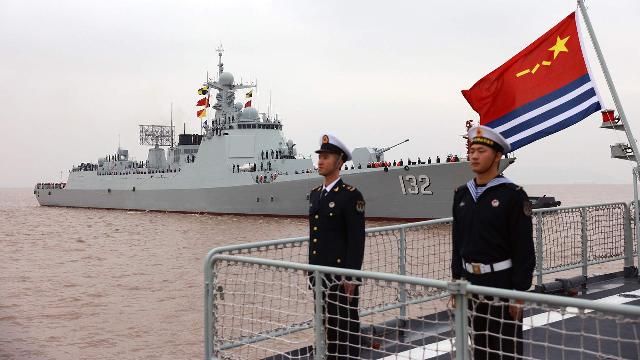Over the decades, the PLA's naval power has grown many times
May of this year turned out to be rich in events related to the naval forces of the People's Liberation Army of China. At the beginning of the month, the third Chinese aircraft carrier Fujian began sea trials. Photos of the new corvette also spread on social networks. It is believed that it will be a platform for comprehensive testing of both new shipbuilding technologies and new weapons systems and on-board equipment. And in addition, satellite photos of Shanghai shipyards show a relatively small new aircraft carrier-type ship, which is suspected to be the first Chinese carrier of combat unmanned systems. How the Chinese Navy has developed in recent decades and in what condition it is today — in the material of Izvestia.
How it all started
Just 30 years ago, the Chinese navy was a strange symbiosis of cosplay from the projects of the Soviet Navy of the 1950s (including the destroyers of Project 56 and submarines of project 633) and a number of ships already of its own design, but with imported combat systems.
The collapse of the USSR and the end of the Cold War, which began in the 1990s, opened up wide military and technical opportunities for China. He literally bought up all the latest military developments of the departed superpower, both in the form of actual equipment and technical documentation. And if Russia tried to sell a batch of finished products, and only then transfer the license, then Ukraine sold everything that was possible, at the same time for mere pennies. So, when China became interested in the Su-33 carrier-based fighter, it was offered to buy a batch of several dozen aircraft. China went to Kiev and took the prototype of this fighter remaining in Crimea. China also bought various military technologies in Europe with might and main, while the country's engineers showed great abilities in the field of reverse engineering, quickly understanding the purchased systems and reproducing them already under their own types of weapons. The same applied to Soviet military systems.
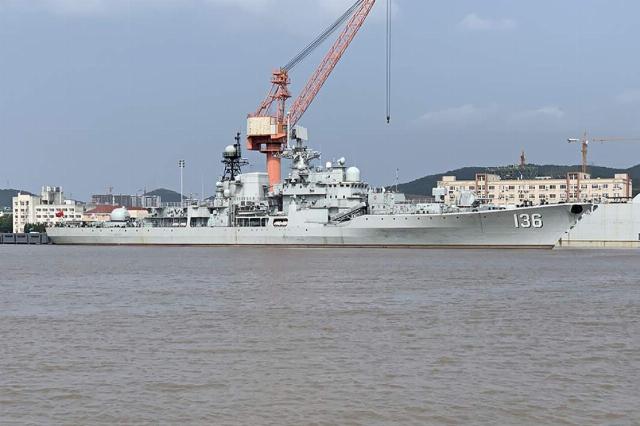
The destroyer of the Hangzhou Project 956
Image Source: Photo: commons.wikimedia.org
In order to better study modern Russian technology and strengthen its Navy, in the 1990s and early 2000s, China bought four destroyers of project 956 and 12 submarines of projects 636 and 877. By and large, the orders of warships and submarines by China, India and other countries in the nineties and noughties saved the military shipbuilding industry in Russia.
The growth of the economy and the knowledge gained allowed the PRC to begin mass construction of warships of its own projects at the beginning of the XXI century.
Aircraft carriers
In the 1990s, China, through various non-governmental structures and under different types of future use, bought the Kiev and Minsk aircraft carriers decommissioned from the Russian Navy. Although both of these ships are currently used in the entertainment industry, there is no doubt that they were first carefully studied by military specialists. But back in the mid-1980s, China managed to buy the decommissioned Australian aircraft carrier Melbourne for scrap. Of course, they did not immediately disassemble the ship, but studied it for a long time, and although the aircraft carrier itself structurally came from the time of World War II, it is better than nothing.
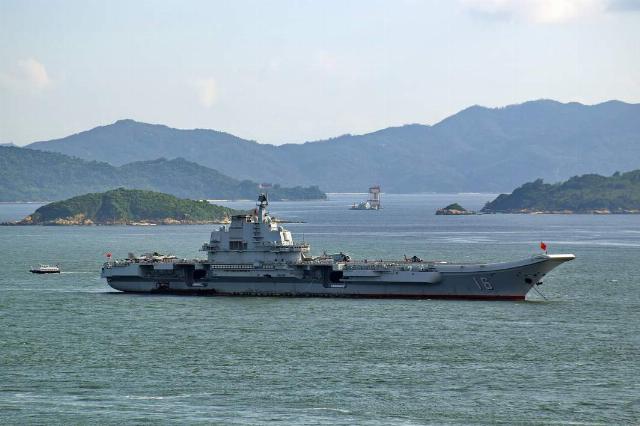
Aircraft carrier Liaoning off the coast of Hong Kong
Image Source: Photo: commons.wikimedia.org
Perhaps, the pearl of the activities of the Chinese special services was the purchase in 1998 in Ukraine of the aircraft carrier "Varyag" project 11456, which remained in Nikolaev. The ship was bought for a couple of tens of millions of dollars, ostensibly for use as a floating casino. As soon as the Varyag was delivered to China, everyone immediately forgot about the casino. Later, Chinese engineers literally accomplished a feat by commissioning a ship called Liaoning in 2012. At the same time, a Chinese naval fighter "Shenyang J-15" appeared on its deck, created on the basis of a purchased prototype of the Su-33 fighter. In total, the Liaoning can carry up to 38 lethal vehicles on board.
The experience gained and the technical documentation of this project purchased in Russia made it possible to put into operation in 2019 the second aircraft carrier Shandong with the possibility of basing more than 40 vehicles. Now the third aircraft carrier has already been tested. The commissioning of the fourth one under construction is not far off, it is possible that it will already be with a nuclear power plant. In total, China plans to have six aircraft carriers in the fleet.
Landing craft
In addition to the Taiwan issue, China has a number of territorial disputes in the South China and East China Seas. Plus, ensuring the safety of the transport route under construction — the "New Silk Road" — requires having strong amphibious forces for the rapid transfer of troops and military equipment to areas of threat.
For example, China is already building a series of eight universal amphibious assault ships (UDC) of project 075. These ships, with a displacement of about 40 thousand tons and a length of 237 m, are comparable in size and tasks to the US Navy's America-type UDC. So far, China does not have shortened takeoff and landing aircraft like the US Navy's F-35C fighter, so these ships carry only up to 30 helicopters. UDC America can not only participate in amphibious operations, but also act as light aircraft carriers. Project 075 can carry up to 1,200 Marines and three landing craft on board.
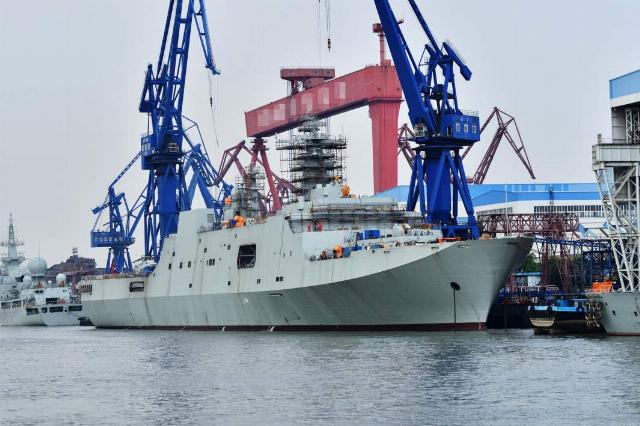
Construction of the UDC project 071 at one of the shipyards in China
Image Source: Photo: commons.wikimedia.org
From 2006 to our time, China has also built eight UDC project 071, with a displacement of 20 thousand tons and a length of 210 m, these ships carry up to 800 Marines, four helicopters and landing boats each. These forces support several dozen smaller tank landing craft.
One of the last conflicts in the field of military-technical cooperation between Russia and Ukraine, even before the Crimean events, was the story of China's purchase of small amphibious hovercraft (MDKVP) of the Zubr type.
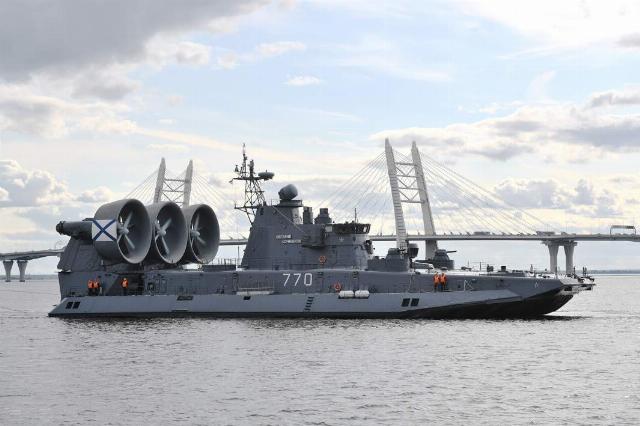
Small amphibious hovercraft project 12322 "Zubr" MDKVP "Evgeny Kocheshkov" at the International Naval Salon in St. Petersburg
Image source: Photo: RIA Novosti/Alexander Galperin
At one time, the USSR created the world's largest MDKVP "Zubr". These floating units could take on board a company of Marines and transfer them at a speed of up to 60 knots (about 111 km/ h) to a distance of up to 300 nautical miles. In fact, these are high-speed ships for the delivery of attack aircraft of the first wave of the landing. For the landing of Chinese soldiers in Taiwan, this is what is needed. When the PRC came to Russia for such ships, they were offered the same conditions. Ukraine, having technical documentation for these ships (they were previously built in Feodosia), slightly rewriting the name — "Bison" instead of "Bison" — offered a more convenient option: two are being built in Crimea and two more under license in China. After the events of spring 2014, our country had to fulfill the contract. Of course, China continued to build such units without any license and the PLA Navy already has at least six such ships.
Destroyers, frigates and corvettes
Aircraft carriers and landing craft must be guarded. To this end, China is massively building destroyers, frigates and corvettes at an amazing rate. In 2019, it was discovered that 15 destroyers of projects 052D and 055 were being built simultaneously at the Jiangnan Shipyard in Shanghai. Among other things, a third Chinese aircraft carrier was also built there.
Eight Project 055 destroyers are already in service. These ships, with a length of 183 m and a displacement of 13 thousand tons, are the second largest destroyers in the world after the miracle of American shipbuilding — the Zamvolt-type destroyers. On board there are 112 vertical launchers for various types of missiles (cruise for action against coastal and naval targets, anti-aircraft, anti-submarine, ballistic anti-ship and hypersonic), a 130 mm cannon and two helicopters. In the future, railguns may also be installed on ships. Apparently, the PRC was able to create its own analogue of the Aegis-type combat information and control system in service with the US Navy, something clearly similar is placed on board these ships. At least eight such units are still under construction.
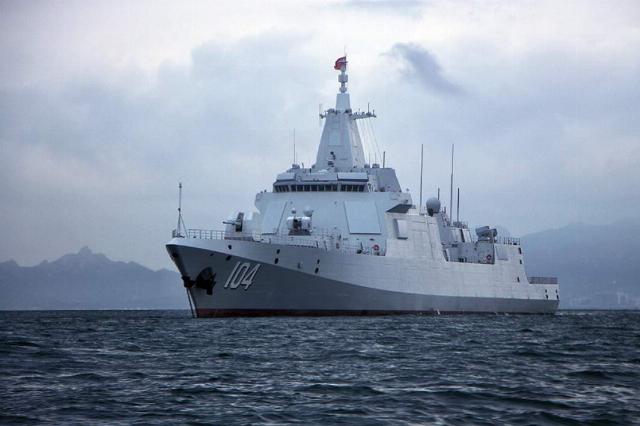
The destroyer of project 055 Wuxi during the exercises
Image Source: Photo: flickr.com
In addition to these ships, Project 052D destroyers are also being built. There are already 25 of them in service and at least seven are still under construction. The ship, with a displacement of 7,500 tons and a length of 161 m, carries 64 vertical launchers, a 130 mm cannon, torpedo tubes and air defense systems on board. Presumably, a hypersonic missile was tested on one of these ships in 2022. Diesel engines and gas turbines are used as engines, the license and documentation for the production of which the PRC received from Germany and Ukraine, respectively.
A number of other destroyers also remain in service, including all four Russian-built Project 956 ships. Unfortunately, we have only one running ship of this series — Admiral Ushakov. The century of such beautiful ships as the destroyers of Project 956 was not long in the Russian Navy. In total, the PLA Navy has about 48 destroyers.
To the above, we can add that the PLA Navy also has 44 frigates, as well as fifty corvettes. In the period 2011-2021, the Chinese Navy and Coast Guard replenished 72 corvettes of project 056, eight more were built for export. There has not been such a large series of warships in the last quarter of a century.
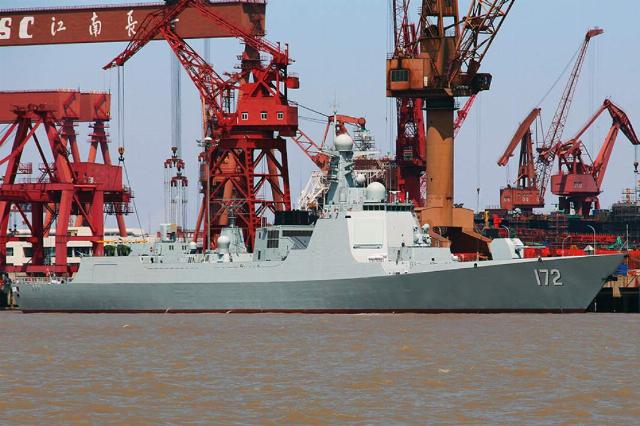
Project 052D Kunming destroyer in Changxing Harbor
Image Source: Photo: commons.wikimedia.org
By building ships for its fleet, China also supplies them outside the Celestial Empire. If Pakistan, Nigeria, Thailand or Bangladesh have long had good military and technical ties with China, then the supply of corvettes to Algeria is very surprising, since Algeria has very close ties with Europe and Russia, and the purchase of Chinese ships speaks volumes, including the quality of their construction.
The Chinese do not forget about support vessels, such as complex supply ships, tankers, reconnaissance and submarine rescue vessels, and other support vessels.
We are currently witnessing a genuine increase in China's naval power. The fleet, which 30 years ago was somehow quite ancient at that time, is currently coming out on top in terms of the number of ships. Technologically and in terms of displacement, the Chinese PLA Navy is catching up with the US Navy.
Dmitry Boltenkov
